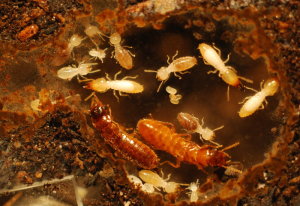 A new study published in the science journal Plos One suggests that human activity may have unintentionally caused the creation of a destructive hybrid termite. In their research article Hybridization of Two Major Termite Invaders as a Consequence of Human Activity, the University of Florida authors’ detail how two different species of termites, both very destructive, have mated to produce hybrid termites that can reproduce twice as fast as the original parent species.
A new study published in the science journal Plos One suggests that human activity may have unintentionally caused the creation of a destructive hybrid termite. In their research article Hybridization of Two Major Termite Invaders as a Consequence of Human Activity, the University of Florida authors’ detail how two different species of termites, both very destructive, have mated to produce hybrid termites that can reproduce twice as fast as the original parent species.
The two termite species that are cross mating are not native to North America and were introduced into the south Florida region by human activity. In 2013 the Formosan subterranean termite (Coptotermes formosanus) and the Asian subterranean termite (C. gestroi) had springtime swarms at the same time. (Termite swarms occur when, at a certain time of year and weather conditions, winged termites, or alates, fly out of their nests to mate and start new colonies. This is how termites spread from building to building and expand their geographic territory.) Normally these two different types of subterranean termites would never swarm at the same time, because they develop wings and swarm under different weather conditions. But when both species were introduced into the south Florida environment and, possibly, the warmer weather caused by climate change have caused both species to swarm at once.
But that’s not the worst part: the two different types of termites are able to cross-breed. Lead author of the research article, Thomas Chouvenc, was fascinated to observe that Asian termites in the wild engaging in mating behavior with Formosan termite females. Back to the laboratory, the inter-species mating behavior also occurred, resulting in the birth of hybrid termites. Several hybrid colonies of Asian and Formosan termites have been established at the Florida lab, although no hybrid termites have yet been observed in the wuild.
And it keeps getting worse… alarmingly, the termite hybrids produced by the mating of Asian and Formosan termites in the lab reproduces much more rapidly than their non-hybrid parents—twice as fast as either species separately. The quick population growth of the new termite species coupled with its voracious appetite for wood could be a deadly combination for Florida home owners—and potentially one day for other parts of the country as well.
Asian and Formosan termites are responsible for billions of dollars of destruction to wood structures worldwide every year. As their name implies, these termite species are native to warm coastal regions in China and Taiwan. But globalization, with international trade and travel, has allowed Asian and Formosan termites to spread worldwide—including to California. Today, the only places the Asian and Formosan colonies overlap, with the potential for cross-breeding, are Taiwan, Oahu in Hawaii, and southeast Florida.
Because both the Asian and Formosan termites like a moist climate such as south Florida, it’s not hybrid termites will arrive in California any time soon. But scientists can’t rule that scenario out. If it turns out that the hybrid termites are able to tolerate more temperate, drier climates, they might be able to move out of south Florida into other parts of the country.
Scientists also worry that climate change may allow other types of termites to swarm, and mate, at the same time—creating more opportunity for inter-species breeding, potentially giving rise to a fast-reproducing super-termite that loves California weather.


